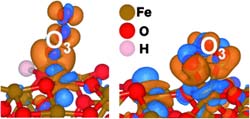Ozone Catcher

Ozone is formed when nitrogen oxide from exhausts is irradiated with UV light and releases an oxygen atom, which reacts with an oxygen molecule (O2) to form an ozone molecule (O3). A number of electrical devices, such as photocopiers and laser printers, also release this unhealthy gas.
In the journal Angewandte Chemie, a team led by Thomas Mathew and Kenichirou Suzuki at Toyota Central R&D Labs Inc. (Japan) report how they have now developed an iron oxide containing material that could lead to a new generation of ozone filters.
Ozone (O3) is a very dangerous air pollutant, irritating the airway and eyes as well as causing headaches. It also hinders plant growth and is believed to play a role in the die-off of forests. The typical “ozone smell” when using older photocopiers and laser printers is not the ozone itself: it is reaction products from the ozone. Most newer devices are equipped with filters that convert the ozone. Removal of O3 is essential for aircraft applications because O3 is an unavoidable pollutant at high altitude and can be introduced into the aircraft cabins during the flight.
Previous materials for the elimination of ozone have a number of disadvantages: for example, some require organic additives, others do not work without expensive metals, some are far from environmentally friendly, and most are not flexible enough for wide use in a variety of applications. The Japanese team has now reported a new, highly promising ozone trap: two-line ferrihydrite, a mineral composed of iron, oxygen, and water. The researchers produce it by a self-assembly process using various additives and solvents. The resulting highly porous material consists of tiny aggregated nanocrystals and its name is derived from the fact that when examined by X-ray diffraction, a technique for structure analysis, it shows two lines.
Why is two-line ferrihydrite such a good ozone catcher? Thanks to its pores and arrangement of nanoparticles, this material has a large and accessible inner surface. In comparison to other iron oxide materials, it has a particularly high proportion of unsaturated and thus reactive iron centers on its surface. These have fewer oxygen atoms as near neighbors than the iron atoms in the interior of the mineral. Such isolated iron oxide units absorb ozone especially well. Once bound to the iron, the ozone splits into an oxygen molecule (O2) and a highly reactive oxygen atom (O), which can react with a second lone oxygen atom to form O2.
This material could replace conventional ozone filters in electrostatic devices and aircraft applications. It can also be used for air-cleaner devices or as a filter in ventilation or air-conditioning ducts in offices and houses. In ozone processes for water cleaning and odor removal, e.g. smoke from vehicle interiors, it could catch the unreacted O3.
Author: Thomas Mathew, Toyota Central R&D Labs, Nagakute-Cho (Japan), mailto:thomasm74@gmail.com
Title: Mesoporous Ferrihydrite-Based Iron Oxide Nanoparticles as Highly Promising Materials for Ozone Removal
Angewandte Chemie International Edition 2011, 50, No. 32, Permalink to the article: http://dx.doi.org/10.1002/anie.201102007
Media Contact
All latest news from the category: Life Sciences and Chemistry
Articles and reports from the Life Sciences and chemistry area deal with applied and basic research into modern biology, chemistry and human medicine.
Valuable information can be found on a range of life sciences fields including bacteriology, biochemistry, bionics, bioinformatics, biophysics, biotechnology, genetics, geobotany, human biology, marine biology, microbiology, molecular biology, cellular biology, zoology, bioinorganic chemistry, microchemistry and environmental chemistry.
Newest articles

Superradiant atoms could push the boundaries of how precisely time can be measured
Superradiant atoms can help us measure time more precisely than ever. In a new study, researchers from the University of Copenhagen present a new method for measuring the time interval,…

Ion thermoelectric conversion devices for near room temperature
The electrode sheet of the thermoelectric device consists of ionic hydrogel, which is sandwiched between the electrodes to form, and the Prussian blue on the electrode undergoes a redox reaction…

Zap Energy achieves 37-million-degree temperatures in a compact device
New publication reports record electron temperatures for a small-scale, sheared-flow-stabilized Z-pinch fusion device. In the nine decades since humans first produced fusion reactions, only a few fusion technologies have demonstrated…





















